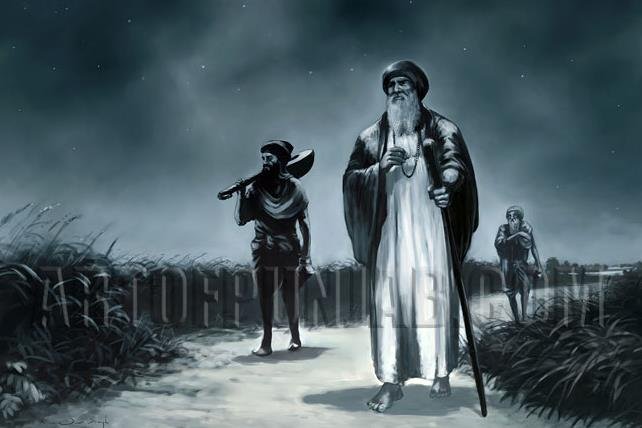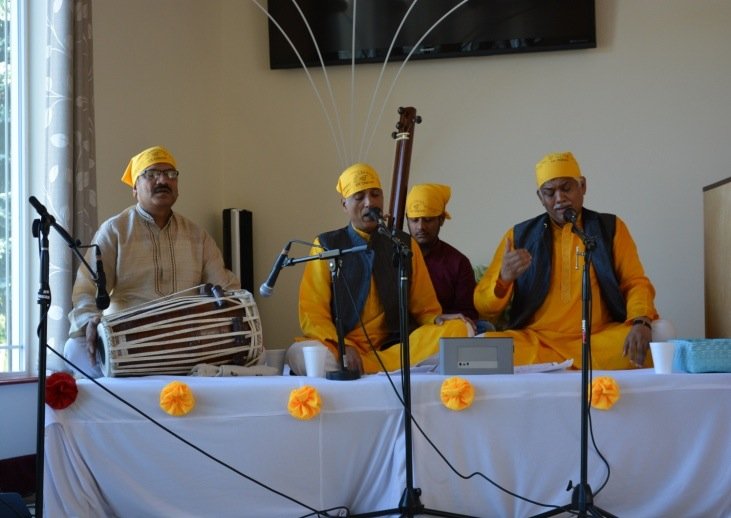Gurbani and Dhrupad - A Brief Exploration
June 30, 2014: “Dhrupad is sound of meditation – worship of naad (sound) – Onkar Saadhnaa. Through the practice and learning of dhrupad, the goal is to achieve Onkaar (Creator). Alaap during dhrupad is the worship of Niraakaar (formless Creator) which is followed by worship of Saakaar (Creation) through words. There is no existence of Niraakaar without Saakaar and no existence of Saakaar without Niraakaar. They both exist together and cannot be separated.”
“Raga is a unique manifestation of our heritage which is found only in India. Every raga has its own character and discipline and it is achieved by meditation. Raga is not just a tune or a dhun, it’s an experience of sound.” These were the words of Pandit Ramkant Gundecha while sharing the basics of Dhrupad and Raga during one of his programs in Seattle, a part of “Dhrupad Days 2014”.
The relationship between Gurbani and Dhrupad goes back to Guru Nanak Sahib (1469-1539), the first Sikh Guru. Guru Nanak Sahib travelled extensively in all four directions and made five major journeys of the world to share the divine message with humanity. During all his journeys he was accompanied by Bhai Mardana (1459–1534), a rabaab player. Bhai Mardana was a close friend of Guru Nanak and a highly accomplished musician of his time.
 |
| Guru Nanak Sahib (Front) and Bhai Mardana (carrying Rabaab) travelling during their long journeys (Photo taken with courtesy from www.ArtOfPunjab.com) |
Swaami Haridaas (1480 -1575), mentor of legendary Taansen and Baiju Baawaraa, was a reputed saint-singer of Dhrupad and developed the pada prabandha style of sung poetry1. A contemporary of Guru Nanak, he composed many four part dhrupad compositions as sthai, antara, sanchari and abhogi. According to some online sources2, Swami Haridas was a student of Bhai Mardana. Pandit Ramakant Gundecha mentioned that Taansen has referred to Lord in his compositions with words like ‘Kartar’ as practiced by Guru Nanak Sahib.
The first five Sikh Gurus (1469-1606) were also great singers and musicologists. It was in 1604 that for the first time, the largest ever collection of sacred hymns of the first five Gurus, fifteen saints and fifteen bards was compiled and named Adi Granth3. The Adi Granth was given the status of Guru Granth Sahib by the tenth Guru, Guru Gobind Singh in 1708. Since 1708, Guru Granth Sahib has been passed unaltered and is considered the greatest repository of divine words with associated musical genres of the era. The majority of shabads in Guru Granth Sahib are categorized according to the Ragas. Out of 60 ragas in Guru Granth Sahib, 32 were created by Sikh Gurus. In additional to classical ragas, many other musical genres, like chantt, vaar, pade, sohelay, ghorian, are also given in Guru Granth Sahib. Among the repertoire surviving from Sikh Guru times, one can observe that all the genres were sung differently.
Dhrupad has been the music of the devotees of India’s many spiritual traditions. The Sikh gurus also expressed deep spiritual mysteries through musical compositions in the dhrupad style. A typical dhrupad composition has four parts: asthai, antara, sanchari and abhog4. Majority of shabads in Guru Granth Sahib have asthai (defined as rahao) which is used as verse to start from and return after singing each pada in a shabad. During Sikh kirtan, utmost importance is given to the clarity of the words in shabad which is always sung in prescribed raga. In dhrupad practice too emphasis is given to correct and clear placement of words and swars. In his analysis of Sikh music, Dr. Gurnam Singh (Professor of Gurmat Sangeet Department at Punjabi University, Patiala, India) comments that a large percentage of Sikh hymns were composed and rendered in dhrupad.
 |
| (Left to right) Bhai Kultar Singh, Bhai Ranjit Singh, Bhai Avtar Singh and Bhai Swarn Singh in Boston (June 2005) – Photo taken with courtesy from GurmatSangeetProject.com7 |
Bhai Avtar Singh and Gurcharan Singh are considered prime practitioners of dhrupad style Gurbani Kirtan in 20th century. Bhai Jawala Singh (father of Bhai Avtar Singh, Gurcharan Singh) was recognized as the leading dhrupad style kirtania in late 19th and early 20th century. Bhai Avtar Singh was prominent supporter of dhrupad and used to mention that all kirtanias in past used to sing first shabad in dhrupad style. They also used to sing the first shabad in dhrupad during their kirtan performance. In their remarkable books ‘Gurbani Sangeet: Pracheen Reet Ratnavali5’ they have given notations of medieval and pre-medieval dhrupad compositions in more than 24 talas. During their 2005 visit to Boston (US), they sang “Gun Naad Dhun Anad Bhed”7 in dhrupad and chartaal.
As part of week-long dhrupad celebration in Seattle “Dhrupad days 2014”, Gundecha brothers performed kirtan of the same shabad “Gun Naad Dhun Anad Bhed” in almost similar dhrupad composition.
 |
| (Left to Right) Pandit Akilesh Gundecha, Pandit Ramakant Gundecha, Nirant Gundecha and Pandit Umakant Gundecha performing kirtan in Seattle (Dhrupad Days, May 2014) |
Bhai Baldeep Singh, founding member of Anad Conservatory, has also been mentored in the dhrupad genre by his granduncles Bhai Avtar Singh and Bhai Gurcharan Singh as well as Ustad Rahim Fahimuddin Dagar. The excerpts from one of his paper provides a nice closing to this short exploration of relationship between Gurbani and Dhrupad as he mentions “Gurbani will prove to be a treasure chest of information not only in relation to dhrupad and the preceding genres, such as chantt and varaan, but also with regard to defining who is a dhrupadiya or a kirtaniya6.”
References:
- Sikh Shabad as a musical construction of memory, Janice Faye Protopapas, PhD thesis, University of Maryland, 2011
- http://en.wikipedia.org/wiki/Swami_Haridas, http://pages.rediff.com/swami-haridas/427269, http://www.shaba.co/wa?s=swami_haridas, http://www.sikh-heritage.co.uk/arts/rebabiMardana/RebabiMardana.htm
- Indian Classical Music And Sikh Kirtan, Gobind Singh Mansukhani , 1982
- The music of the Sikh Gurus, Tradition in Western context: Cross-cultural pedagogy and research, Francesca Cassio Sikh Formations, Vol. 7, No. 3, December 2011, pp. 313–337
- Gurbani Sangeet: Pracheen Reet Ratnavali, Bhai Avtar Singh and Bhai Gurcharan Singh, 1988/1979. Volume 1. (1988), Volume 2 (1979), Punjabi University Publication Bureau
- What is Kirtan? Observations, interventions and personal reflections, Bhai Baldeep Singh, Sikh Formations, Vol. 7, No. 3, December 2011, pp. 245–295
- Gurmat Sangeet Project (www.GurmatSangeetproject.com)
- Art of Punjab http://www.artofpunjab.com/guru-nanak-blue-tonal/
